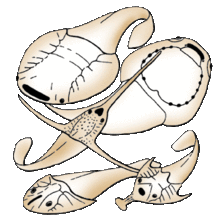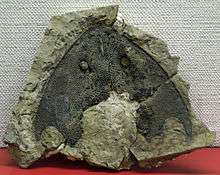Galeaspida
| Galeaspida Temporal range: 430–400 Ma | |
|---|---|
| | |
| Scientific classification | |
| Kingdom: | Animalia |
| Phylum: | Chordata |
| Subphylum: | Vertebrata |
| Class: | †Galeaspida Liu, 1965 |
| Orders | |
|
Galeaspidiformes Liu, 1965 | |
Galeaspida (from Latin, "Helmet shields") is an extinct taxon of jawless marine and freshwater fish. The name is derived from galea, the Latin word for helmet, and refers to their massive bone shield on the head. Galeaspida lived in shallow, fresh water and marine environments during the Silurian and Devonian times (430 to 370 million years ago) in what is now Southern China, Tibet and Vietnam. Superficially, their morphology appears more similar to that of Heterostraci than Osteostraci, there being currently no evidence that the galeaspids had paired fins. However, Galeaspida are in fact regarded as being more closely related to Osteostraci, based on the closer similarity of the morphology of the braincase.
Morphology



The defining characteristic of all galeaspids was a large opening on the dorsal surface of the head shield, which was connected to the pharynx and gill chamber, and a scalloped pattern of the sensory-lines.
The opening appears to have served both the olfaction and the intake of the respiratory water similar to the nasopharyngeal duct of hagfishes.[1] Galeaspids are also the vertebrates which have the largest number of gills, as some species of the order Polybranchiaspidida (literally "many gills shields") had up to 45 gill openings. The body is covered with minute scales arranged in oblique rows and there is no other fin besides the caudal fin. The mouth and gill openings are situated on the ventral side of the head, which is flat or flattened and suggests that they were bottom-dwellers.
Taxonomy
There are around 76 + described species of galeaspids in at least 53 genera.
If the families Hanyangaspidae and Xiushuiaspidae can be ignored as basal galeaspids, the rest of Galeaspida can be sorted into two main groups: the first being the order Eugaleaspidiformes, which comprises the genera Sinogaleaspis, Meishanaspis, and Anjianspis, and the family Eugaleaspididae, and the second being the Supraorder Polybranchiaspidida, which comprises the order Polybranchiaspidiformes, which is the sister taxon of the family Zhaotongaspididae and the order Huananaspidiformes, and the family Geraspididae, which is the sister taxon of Polybranchiaspidiformes + Zhaotongaspididae + Huananaspidiformes.
Some experts demote Galeaspida to the rank of subclass, and unite it with Pituriaspida and Osteostraci to form the class Monorhina.
Fossil Record
The oldest known galeaspids, such as those of the genera Hanyangaspis and Dayongaspis, first appear near the start of the Telychian age, of the latter half of the Llandovery Epoch of the Silurian, about 436 million years ago. During the transition from the Llandovery to the Wenlock, the Eugaleaspids underwent a diversification event. By the time the Wenlock epoch transitioned into the Ludlow Epoch, all of the eugaleaspids, save for the Eugaleaspidae, were extinct. The Eugaleaspidae lived from the Wenlock, and were fairly long-lived, especially the genus Eugaleaspis. The last of the Eugaleaspididae disappeared by the end of the Pragian Epoch of the Lower Devonian.
The first genus of Geraspididae, the eponymous Geraspis, appears during the middle of the Telychian. The other genera of Polybranchiaspidida appear in the fossil record a little after the beginning of the Lochkovian Epoch, at the start of the Devonian. The vast majority of the supraorder's genera either date from the Pragian epoch, or have their ranges end there. By the time the Emsian epoch starts, only a few genera, such as Duyunolepis and Wumengshanaspis, survive, with most others already extinct. The last galeaspid is an as yet undescribed species and genus from the Fammenian epoch of the Late Devonian, found in association with the tetrapod Sinostega and the antiarch placoderm Remigolepis, in strata from the Northern Chinese province of Ningxia.
Taxa
Basal Galeaspids
Hanyangaspididae
Hanyangaspididae contains the following genera: Hanyangaspis, Nanjiangaspis, Kalpinolepis, and Konoceras
Xiushuiaspididae
Xiushuiaspididae contains the following genera: Xiushuiaspis, Changxingaspis, and Microphymaspis
Dayongaspididae
Dayongaspididae contains the following genera: Dayongaspis and Platycarpaspis
Eugaleaspidiformes
Eugaleaspidiformes includes the family Eugaleaspididae, and several genera exclusive of that family.
Genera exclusive of Eugaleaspididae
Anjiaspis, Dunyu, Meishanaspis, Shuyu, and Sinogaleaspis
Eugaleaspididae
This is a derived branch within Eugaleaspidiformes, and includes the following genera: Eugaleaspis, Nochelaspis, Pterogonaspis, Tridenaspis, and Yunnanogaleaspis
Polybranchiaspidida
Polybranchiaspidida includes the subtaxon Polybranchiaspidiformes and its sister taxa, as well as the order Huananaspidiformes, and its sister taxon, the family Zhaotongaspididae
Polybranchiaspidiformes
Polybranchiaspidiformes proper contains three families, not including basal taxa.
Basal Polybranchiaspidiformes
Basal polybranchiaspidiform galeaspids include the genus Gumuaspis, and the family Geraspididae, comprising the genera Geraspis and Kwangnanaspis
Pentathyraspididae
This family contains Pentathyraspis and Microhoplonaspis
Duyunolepididae
This family contains Duyunolepis, Pseudoduyunolepis, Paraduyunolepis, Neoduyunolepis, and Lopadaspis
Polybranchiaspididae
This family contains Polybranchiaspis, Bannhuanaspis, Clororbis, Dongfangaspis, Siyingia, Hyperaspis, Laxaspis, Diandongaspis, Damaspis, and Cyclodiscaspis
Huananaspidiformes
The order Huananaspidiformes contains the genus Sanqiaspis, and three families, not including its sister taxon, Zhaotongaspididae.
Zhaotongaspididae
This family of basal Hunanaspidiform galeaspids contains two genera, including Zhaotongaspis, and Wenshanaspis
Sanchaspididae
This family contains two genera, Sanchaspis (not to be confused with Sanqiaspis), and Antiquisagittaspis
Gantarostraspididae
This family contains three genera, Gantarostraspis, Wumengaspis and the recently described Rhegmaspis
Huananaspidae
Huanaspidae contains eight genera. Four genera, Macrothyraspis, Lungmenshanaspis, Qingmenaspis and Sinoszechuanaspis, are group together in a subfamily, "Macrothyraspinae." The other four genera are Huanaspis , Asiaspis, Nanpanaspis, and Stephaspis. Huanaspis is the sister-taxon of Macrothyraspinae.
See also
References
- ↑ Fossil jawless fish from China foreshadows early jawed vertebrate anatomy The galeaspids are characterized by a large median dorsal opening in the anterior part of the headshield that serves as both a common nostril and the main water intake device.
- Pan Jiang, "New Galeaspids (Agnatha) From the Silurian and Devonian of China In English" 1992, ISBN 7-116-01025-4
- Janvier, Philippe. Early Vertebrates Oxford, New York: Oxford University Press, 1998. ISBN 0-19-854047-7
- Long, John A. The Rise of Fishes: 500 Million Years of Evolution Baltimore: The Johns Hopkins University Press, 1996. ISBN 0-8018-5438-5
- Zhu Min, Gai Zhikun. "Phylogenetic relationships of Galeaspids (Agnatha)" 2007 :Higher Education Press and Springer-Verlag 2007
- Fishes of the World 4th edition (Joseph S. Nelson 2006)